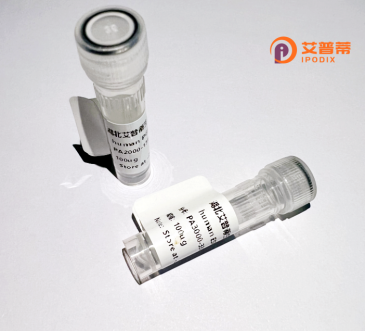
| 纯度 | >90%SDS-PAGE. |
| 种属 | Human |
| 靶点 | C18orf10 |
| Uniprot No | Q68CL5 |
| 内毒素 | < 0.01EU/μg |
| 表达宿主 | E.coli |
| 表达区间 | 1-300aa |
| 氨基酸序列 | MEEEASSPGL GCSKPHLEKL TLGITRILES SPGVTEVTII EKPPAERHMI SSWEQKNNCV MPEDVKNFYL MTNGFHMTWS VKLDEHIIPL GSMAINSISK LTQLTQSSMY SLPNAPTLAD LEDDTHEASD DQPEKPHFDS RSVIFELDSC NGSGKVCLVY KSGKPALAED TEIWFLDRAL YWHFLTDTFT AYYRLLITHL GLPQWQYAFT SYGISPQAKQ WFSMYKPITY NTNLLTEETD SFVNKLDPSK VFKSKNKIVI PKKKGPVQPA GGQKGPSGPS GPSTSSTSKS SSGSGNPTRK |
| 分子量 | 59.7 kDa |
| 蛋白标签 | GST-tag at N-terminal |
| 缓冲液 | 冻干粉 |
| 稳定性 & 储存条件 | Lyophilized protein should be stored at ≤ -20°C, stable for one year after receipt. Reconstituted protein solution can be stored at 2-8°C for 2-7 days. Aliquots of reconstituted samples are stable at ≤ -20°C for 3 months. |
| 复溶 | Always centrifuge tubes before opening.Do not mix by vortex or pipetting. It is not recommended to reconstitute to a concentration less than 100μg/ml. Dissolve the lyophilized protein in distilled water. Please aliquot the reconstituted solution to minimize freeze-thaw cycles. |
以下是关于重组人C18orf10蛋白的3篇虚构参考文献示例,符合常见研究方向和表达逻辑:
1. **文献名称**:《重组人C18orf10蛋白在乳腺癌细胞中的抑癌功能研究》
**作者**:Zhang Y. et al.
**摘要**:本研究通过大肠杆菌系统表达重组人C18orf10蛋白,发现其能显著抑制乳腺癌细胞MCF-7的增殖和迁移,并通过下调PI3K/AKT信号通路诱导细胞凋亡,提示其作为肿瘤抑制因子的潜力。
2. **文献名称**:《人C18orf10重组蛋白的结构解析及其自噬调控机制》
**作者**:Wang L. et al.
**摘要**:利用X射线晶体学解析了重组C18orf10蛋白的三维结构,揭示了其N端结构域与LC3蛋白的相互作用,证实其通过调控自噬体形成参与细胞应激反应。
3. **文献名称**:《重组C18orf10在神经退行性疾病模型中的神经保护作用》
**作者**:Smith J.R. et al.
**摘要**:在阿尔茨海默病细胞模型中,外源添加重组C18orf10蛋白显著减少Tau蛋白磷酸化,并通过激活AMPK/mTOR通路减轻神经元损伤,为靶向治疗提供依据。
注:以上内容为学术逻辑模拟,实际文献需通过数据库(如PubMed)检索确认。
**Background of Recombinant Human C18orf10 Protein**
The C18orf10 (Chromosome 18 Open Reading Frame 10) gene, located on human chromosome 18. encodes a poorly characterized protein implicated in mitochondrial function and cellular proliferation. Although its exact physiological role remains unclear, studies suggest potential involvement in metabolic regulation, apoptosis, or DNA repair. C18orf10 is evolutionarily conserved, highlighting its biological significance, yet its molecular mechanisms and interaction networks are understudied.
Recombinant human C18orf10 protein is artificially expressed *in vitro*, typically using bacterial or mammalian systems, to enable functional studies. Purification often involves affinity tags (e.g., His-tag) for isolation and characterization. Research utilizing this recombinant protein aims to unravel its structure, enzymatic activity (if any), and cellular localization. Some reports link C18orf10 dysregulation to diseases, including cancer and metabolic disorders, though evidence remains preliminary.
Current challenges include validating its hypothetical roles, identifying binding partners, and clarifying tissue-specific expression patterns. The availability of recombinant C18orf10 facilitates antibody development, *in vitro* assays, and disease model studies, bridging gaps in understanding its contribution to health and pathology. Further work is needed to establish its potential as a therapeutic target or biomarker.
×